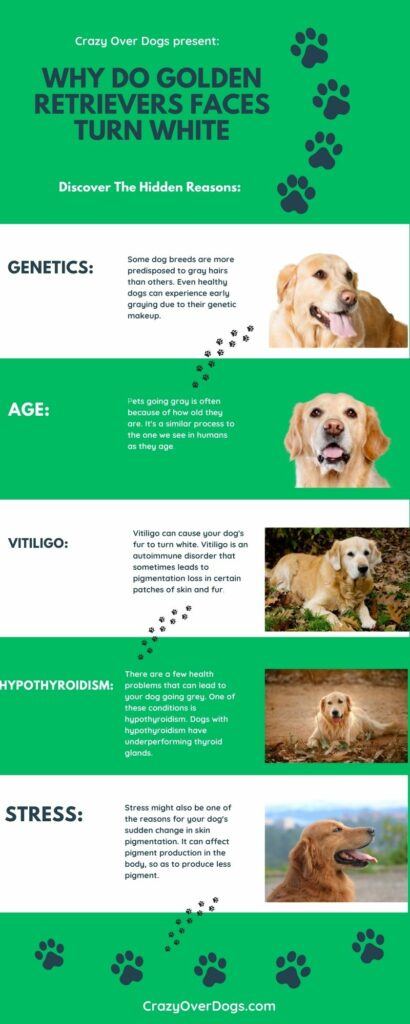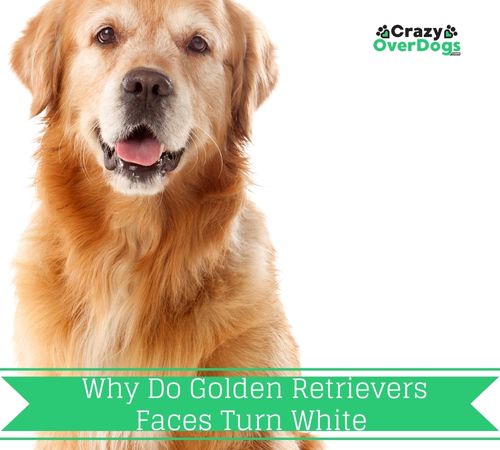Golden retrievers are one of the best dog breeds in the world. They are friendly and great. However, why do golden retrievers’ faces turn white?
Have you noticed that as golden retriever ages, its face often turns white or gray? It can be alarming to the owner. However, in most cases, this doesn’t mean there’s something wrong with them and it might just be their natural genetics coming out.
This is something you may have been wondering about lately and at what age that usually happens for this beautiful dog.
This article takes around 4 minutes to read. However, if you are in a hurry we have included a table of contents so you can see at a glance what the content is.
Make sure to check out today’s deals to SAVE money on dog products by clicking on the graphic below. Don’t miss out.
This post contains affiliate links and I will be compensated if you make a purchase after clicking on my links.
——————————–
Table Of Contents
Why Do Golden Retrievers Faces Turn White Infographic:

Click Here For Full Size Image Plus Embed Code For Your Website
——————————-
Here are the main reasons why your Golden Retriever’s face turns white.
Genetics Can Play a Part:
Some dog breeds are more predisposed to gray hairs than others. For example, it may seem like your dog is too young to be graying but the truth is genetics can play a role in when their fur starts to go white.
Even healthy dogs can experience early graying due to their genetic makeup. Even puppies can have grayed hair, and this greying can become more silver as they age.
————————–
Age Plays a Major Part:
Pets going gray is often because of how old they are. It’s a similar process to the one we see in humans as they age. Dogs don’t suffer from gray hair throughout their entire coat. They tend to gray around the muzzle and face, and this graying usually starts with a salt-and-pepper look.
——————————
Vitiligo:
Vitiligo can cause your dog’s fur to turn white. This health issue is an autoimmune disorder that sometimes leads to pigmentation loss in certain patches of skin and fur.
Scientists believe that vitiligo is hereditary, but it also can appear when something happens in the body of your dog that prevents melanin to be produced.
All dogs will get vitiligo in different areas of their skin. Some dogs may suffer from the condition throughout their whole body but others may only be affected in certain parts.
——————————-
Hypothyroidism:
There are a few health problems that can lead to your dog going grey. One of these conditions is hypothyroidism. Dogs with hypothyroidism have underperforming thyroid glands.
Many people think that the symptoms of hypothyroidism are limited to weight gain, hair loss and skin problems. The truth is that while they are definitely a few symptoms on their own, there are many more associated with this condition. When you provide your dog with the proper treatment for thyroid conditions it will reverse the graying of its fur and also help restore skin health.
——————————-
Stress:
Stress might also be one of the reasons for your dog’s sudden change in skin pigmentation. It is possible that stress will somehow affect pigment production in the body, so as to produce less pigment
The veterinary professionals are the people you should be consulting if you have any concerns about the well-being of your pet. They will advise what stress levels are too high and what to do to bring them down.
——————————-
The Golden Retriever Breed:

Golden Retrievers are well known for their amiable personality, intelligence and high levels of patience. These dogs are highly regarded in the United States, with golden retrievers being the most popular breed in America. They rank as one of the top 10 most popular breeds in the UK as well.
Personality:
They have a reputation for being kind, gentle, and patient with children. They also have a reputation for being obedient and eager to please their owners. These are some of the best qualities that golden retrievers possess and they are excellent family pets.
Golden retrievers are intelligent dogs that can be trained to be service dogs. These dogs are typically very tolerant, energetic, and gentle. and have a high ability to learn new skills and make great pets for many people.
History:
Golden Retrievers were originally bred in 19th-century Scotland as hunting dogs specializing in water and land retrieval.
The retriever’s talents of a retriever, namely the golden retriever’s abilities to go for waterfowl and bring birds back unharmed, were mixed with other retrievers to create the Labrador Retriever.
They were registered as Golden Flatcoats until 1913, then changed to Golden Retrievers or Yellow Retrievers in 1920. The name we use now for them is the one they adopted at that time.
The average lifespan of a golden retriever is 10 to 13 years. They typically weigh between 27 and 34 kg. The height goes from 51 to 61 cms.
—————————
Conclusion:
It can sometimes be hard to recognize factors leading to those telltale signs on your furry friend’s coat. There can be a number of causes, but it often has to do with age.
Many people notice that their golden retriever is beginning to turn gray as they age, but generally don’t worry unless he is displaying other health issues! As always please consult your vet with any concerns about the health of your pet.
—————————
Disclaimer: All material on this website is provided for your information only. It may not be construed as medical advice. No action or inaction should be taken based solely on the contents of this information. Instead, readers should consult appropriate health professionals or veterinarians on any matter relating to their pet’s health and well-being. The publisher is not responsible for errors or omissions.


